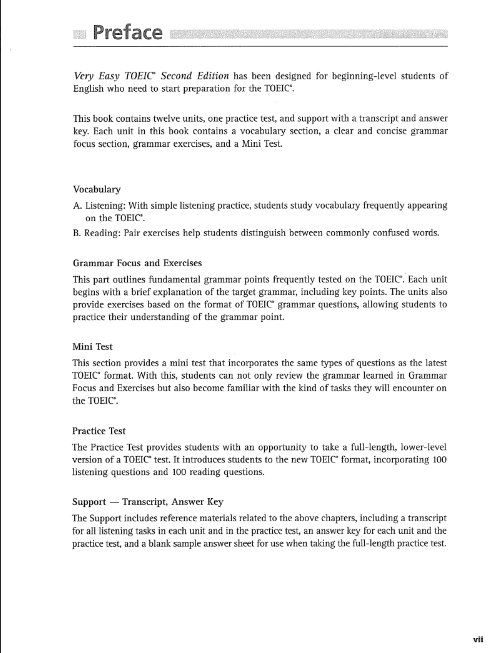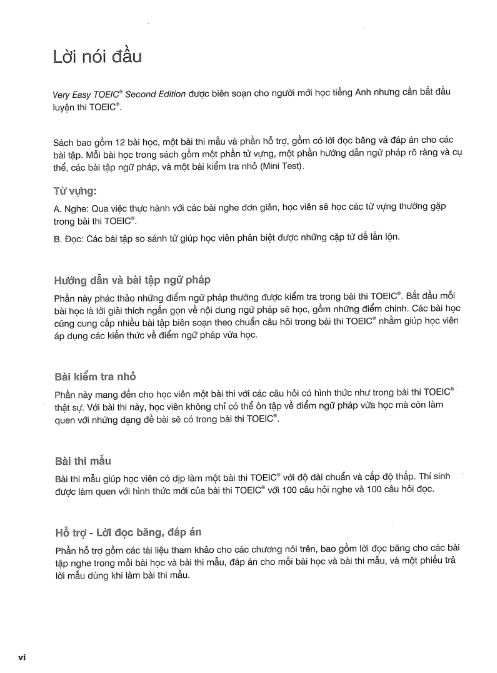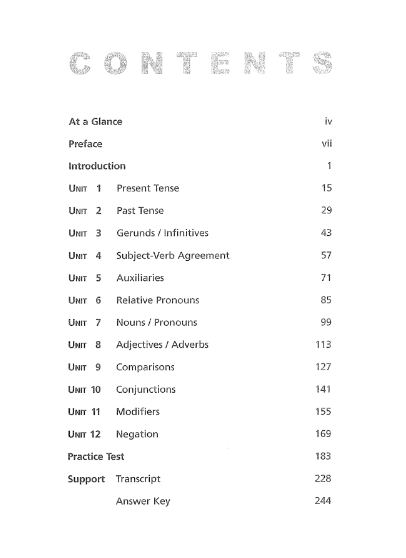


**Lời nói đầu** Very Easy TOEIC® Second Edition đã được biên soạn cho người mới học tiếng Anh nhưng cần bắt đầu luyện thi TOEIC®. Sách bao gồm 12 bài học, mỗi bài thi mẫu và phần hỗ trợ, gồm có lời đọc băng và đáp án cho các bài tập. Mỗi bài học trong sách gồm phần từ vựng, một phần hướng dẫn ngữ pháp rõ ràng và cụ thể, các bài tập ngữ pháp, và một bài kiểm tra nhỏ (Mini Test). **Từ vựng:** A. Nghe: Qua việc thực hành với các bài nghe đơn giản, học viên sẽ học các từ vựng thường gặp trong bài thi TOEIC®. B. Đọc: Các bài tập so sánh từ giúp học viên phân biệt được những câu từ dễ lẫn lộn. **Hướng dẫn và bài tập ngữ pháp** Phần này phác thảo những điểm ngữ pháp được kiểm tra tra trong bài thi TOEIC®. Bắt đầu mỗi bài học là lời giải thích ngắn gọn về nội dung ngữ pháp sẽ học, gồm những điểm chính. Các bài học cũng cung cấp nhiều bài tập biên soạn theo chuẩn câu hỏi trong bài thi TOEIC® nhằm giúp học viên áp dụng các kiến thức và điểm ngữ pháp vừa học. **Bài kiểm tra nhỏ** Phần này mang đến cho học viên một bài thi có các câu hỏi có hình thức như trong bài thi TOEIC® thật sự. Bài thi này, học viên không chỉ có thể ôn tập về điểm ngữ pháp vừa học mà còn làm quen với những dạng đề bài sẽ có trong bài thi TOEIC®. **Bài thi mẫu** Bài thi mẫu giúp học viên có dịp làm quen một bài thi TOEIC® với độ dài chuẩn và cấp độ thấp. Thí sinh được làm quen với hình thức thi của bài TOEIC® với 100 câu hỏi nghe và 100 câu hỏi đọc. **Hỗ trợ – Lời đọc băng, đáp án** Phần hỗ trợ gồm các tài liệu tham khảo cho các chương nối trên, bao gồm lời đọc băng cho các bài tập nghe trong mỗi bài học và bài thi mẫu, đáp án cho mỗi bài học và bài thi mẫu, và một phiếu trả lời mẫu dùng khi làm bài thi mẫu. vi **Hình ảnh 2 (Tiếng Anh):** **Preface** Very Easy TOEIC® Second Edition has been designed for beginning-level students of English who need to start preparation for the TOEIC®. This book contains twelve units, one practice test, and support with a transcript and answer key. Each unit in this book contains a vocabulary section, a clear and concise grammar focus section, grammar exercises, and a Mini Test. **Vocabulary** A. Listening: With simple listening practice, students study vocabulary frequently appearing on the TOEIC®. B. Reading: Pair exercises help students distinguish between commonly confused words. **Grammar Focus and Exercises** This part outlines fundamental grammar points frequently tested on the TOEIC®. Each unit begins with a brief explanation of the target grammar, including key points. The units also provide exercises based on the format of TOEIC® grammar questions, allowing students to practice their understanding of the grammar point. **Mini Test** This section provides a mini test that incorporates the same types of questions as the latest TOEIC® format. With this, students can not only review the grammar learned in Grammar Focus and Exercises but also become familiar with the kind of tasks they will encounter on the TOEIC®. **Practice Test** The Practice Test provides students with an opportunity to take a full-length, lower-level version of a TOEIC® test. It introduces students to the new TOEIC® format, incorporating 100 listening questions and 100 reading questions. **Support — Transcript, Answer Key** The Support includes reference materials related to the above chapters, including a transcript for all listening tasks in each unit and in the practice test, an answer key for each unit and the practice test, and a blank answer sheet for use when taking the full-length practice test. vii **Hình ảnh 3 (Tiếng Việt):** **Bài thi Nghe** Trong bài thi này bạn cần thể hiện năng lực nghe hiểu tiếng Anh của mình. Gồm có bốn phần thi, mỗi phần có hướng dẫn làm bài riêng. **Phần 1 Mô tả tả** Hướng dẫn làm bài cho phần 1 như sau: Hướng dẫn: Trong phần thi này, bạn sẽ nghe đọc câu về mỗi hình ảnh trong quyển đã thi. Sau khi nghe cả bốn câu, bạn phải chọn câu mô tả đúng nhất về những gì bạn thấy trong hình. Sau đó, tìm số thứ tự câu hỏi trên phiếu trả lời và đánh dấu vào lựa chọn của mình. Các câu chỉ được đọc một lần và không được in trong quyển để thi. Xem ví dụ sau đây: Lắng nghe bốn câu sau: (A) Người phụ nữ đang dùng một nhạc cụ. (B) Người phụ nữ đang đánh chữ trên máy tính. (C) Người phụ nữ đang chơi trò chơi điện tử. (D) Người phụ nữ đang ngồi sau bàn. Đáp án mẫu: A B C D Câu (B), “Người phụ nữ đang đánh chữ trên máy tính” mô tả đúng nhất hình ảnh bạn nhìn thấy. Vì vậy bạn nên đánh dấu lựa chọn (B). **Bí quyết làm bài** * Xem qua hình ảnh trước khi nghe đọc các câu mô tả. Tự trả lời các câu hỏi hỏi “Ai?”, “Cái gì?”, “Ở đâu?”. * Tập trung để hiểu nghĩa tổng thể của các câu mô tả. * Trả lời các câu hỏi hỏi càng nhanh càng tốt. Nếu không có câu trả lời thì hãy cố gắng để chọn một câu trả lời sang xem hình ảnh kế tiếp. **Bẫy trong câu hỏi** * Có thể có những từ có âm tương tự trong các lựa chọn câu trả lời sai so với câu trả lời đúng. Ví dụ: The woman is trying on a computer. The woman is tying on a computer. * Các lựa chọn câu trả lời sai có thể có cùng dữ đại từ, số lượng hay trí sai so với câu trả lời đúng. Ví dụ: He is typing on a computer. / There are two computers. / The woman is sitting under the sofa. * Các lựa chọn câu trả lời sai có thể có cùng đúng một từ sai so với câu trả lời đúng. Ví dụ: The computer is for sale. / The woman is sitting with some friends. **Hình ảnh 4 (Tiếng Anh):** **LISTENING TEST** In this section of the test, you will have the chance to show how well you understand spoken English. There are four parts to this section, with special directions for each part. **Part 1 Picture Description** The directions for Part 1 of the TOEIC® appear on the test as follows: Directions: In this part of the test, you will hear four statements about each picture in your textbook. After listening to all four statements, you must select the one statement that best describes what you see in the picture. Then, find the number of that question on your answer sheet and mark your answer. The statements will be spoken only one time, and are not printed in your test book. Look at the sample below. Now listen to the four statements. (A) The woman is using a musical instrument. (B) The woman is typing on a computer. (C) The woman is playing a video game. (D) The woman is sitting behind the table. Sample Answer: ① ② ③ ④ Statement (B), “The woman is typing on a computer,” best describes what you see in the picture. Therefore, you should choose answer (B). **TIPS** * Preview the picture before the statements are read. Ask yourself, “Who?” “What?” “Where?” * Focus on the meaning of the statements as a whole. * Answer the question as quickly as possible. If you don’t know the answer, guess and begin previewing the next picture. **TRICKS** * Incorrect answers may contain similar sounding words. e.g. The woman is tying on a computer. * Incorrect answers may give wrong pronouns, numbers, and locations. e.g. He is typing on a computer. / There are two computers. / The woman is sitting under the sofa. * Incorrect answers may include a correct word. e.g. The computer is for sale. / The woman is sitting with some friends.
**Part 2 Questions and Responses** The directions for Part 2 of the TOEIC® appear on the test as follows: Directions: In this part of the test, you will hear a question or statement followed by three responses. Select the best response to the question or statement and mark the letter (A), (B), or (C) on your answer sheet. Each question will be spoken only one time and will not be printed in your test book. Now listen to the three statements. You will hear: Good morning, John. How are you? You will also hear: (A) I’m fine, thank you. (B) I’m in the living room. (C) My name is John. Sample Answer: ① ② ③ The best response to the question “How are you?” is choice (A), “I’m fine, thank you.” Therefore, you should choose answer (A). **TIPS** * The first word of the question will help you to know what kind of answer is required. What, where, who, why, how—usually seek a yes/no answer. * Questions that contain “or” and require a choice never have yes/no answers. “Did you stay home or go out last night?” “I went to a movie.” * Sometimes you will hear a statement, not a question. However, it still requires an answer. “Thanks for dinner.” “You’re welcome.” **TRICKS** * Pay attention to words that sound the same (homonyms). e.g. two, too, to * Look out for tag questions that are added to the end of statements. e.g. “That movie was great, wasn’t it?” * Watch out for indirect answers. Sometimes the answer to a yes/no question does not include the words “yes” or “no.” e.g. “Is there enough gas in the car?” “I just filled it yesterday.”


